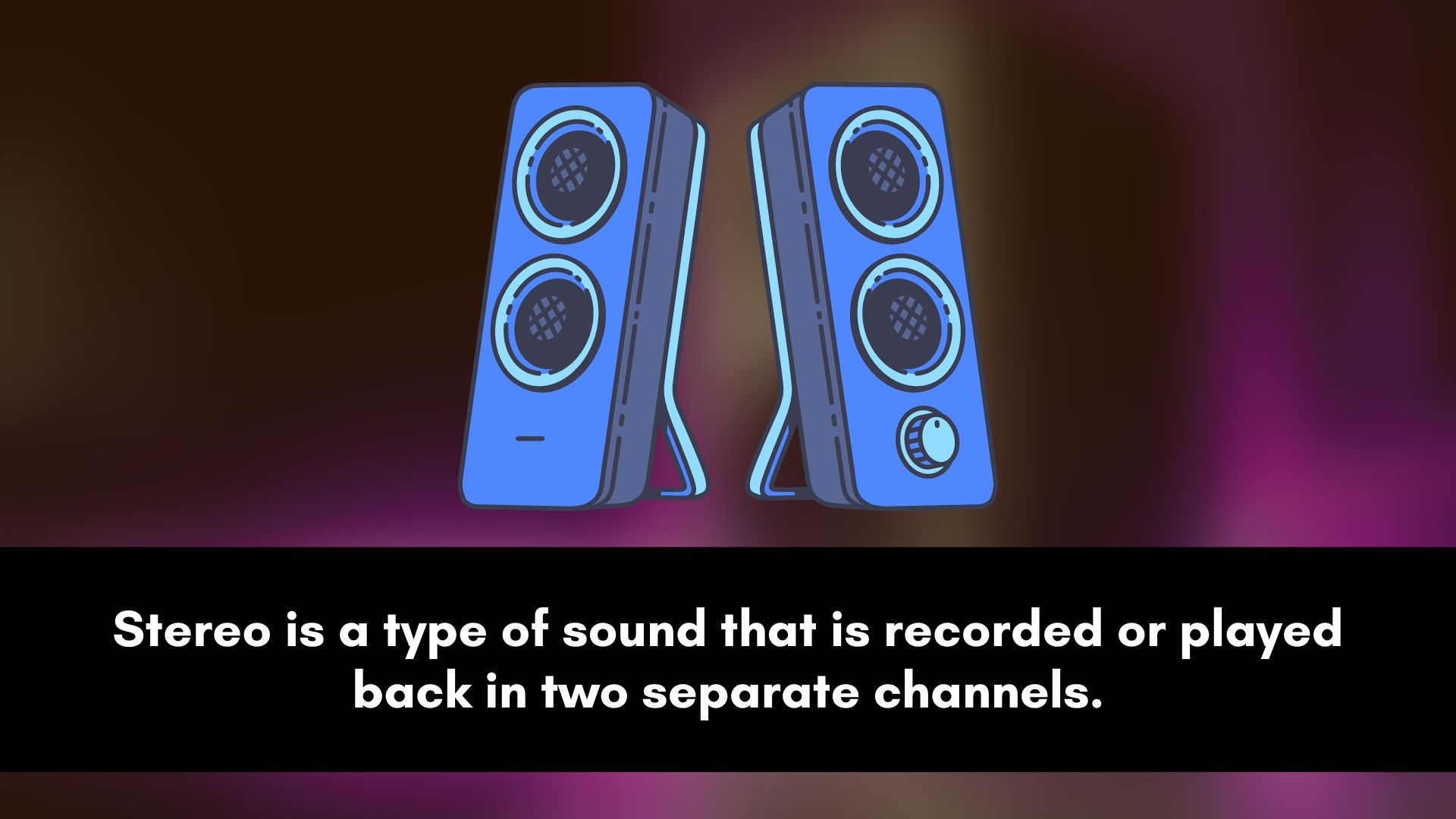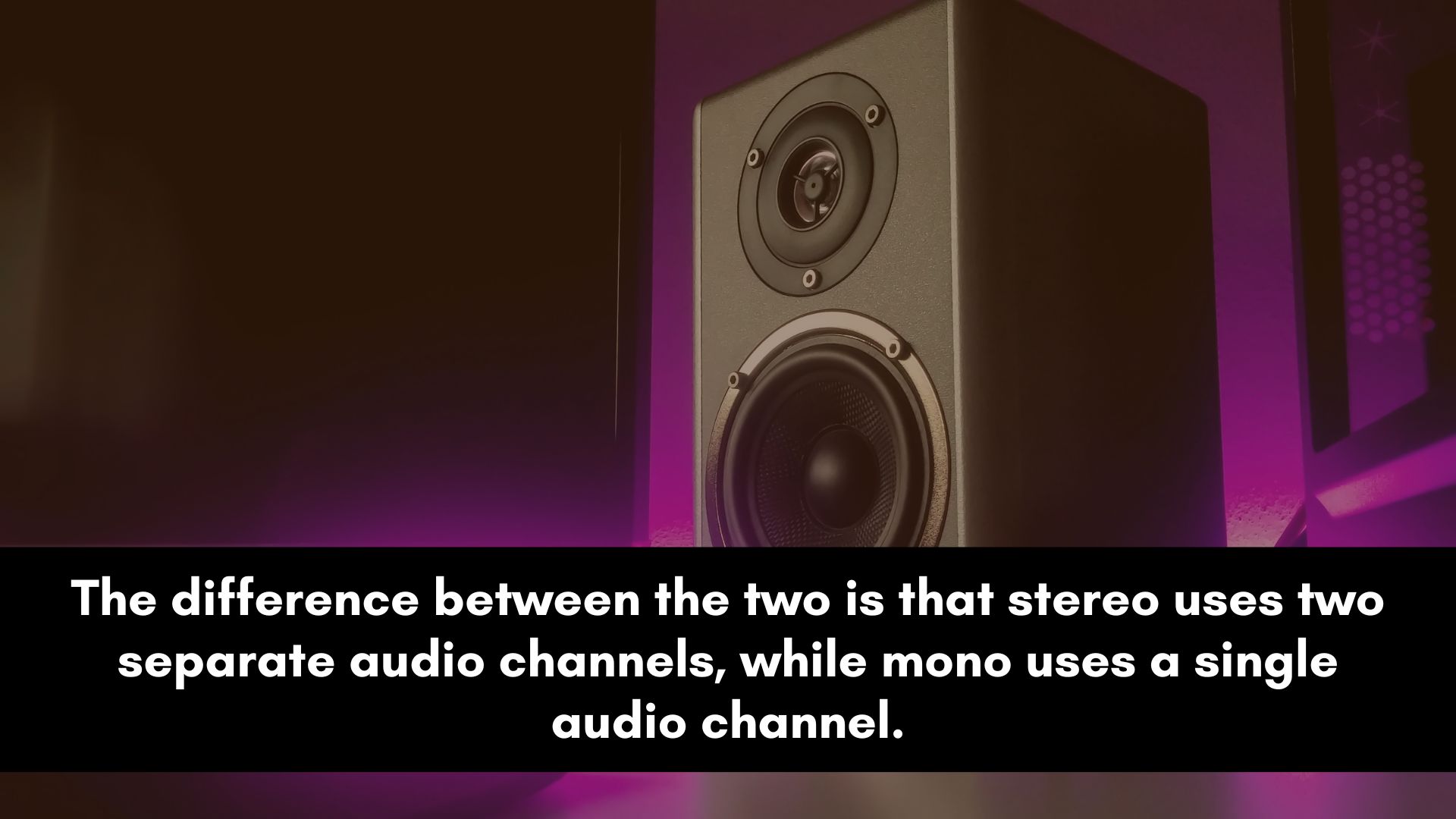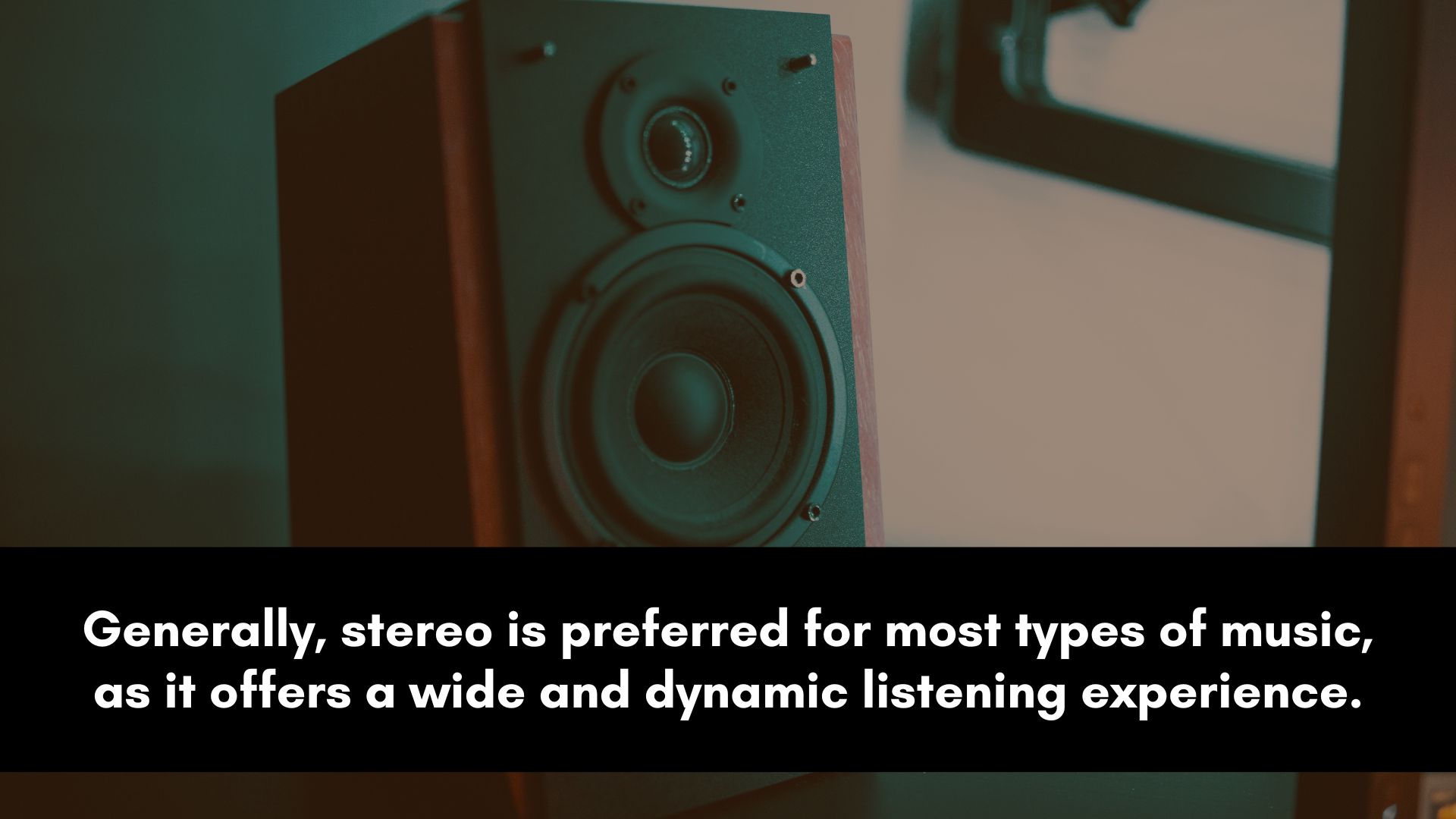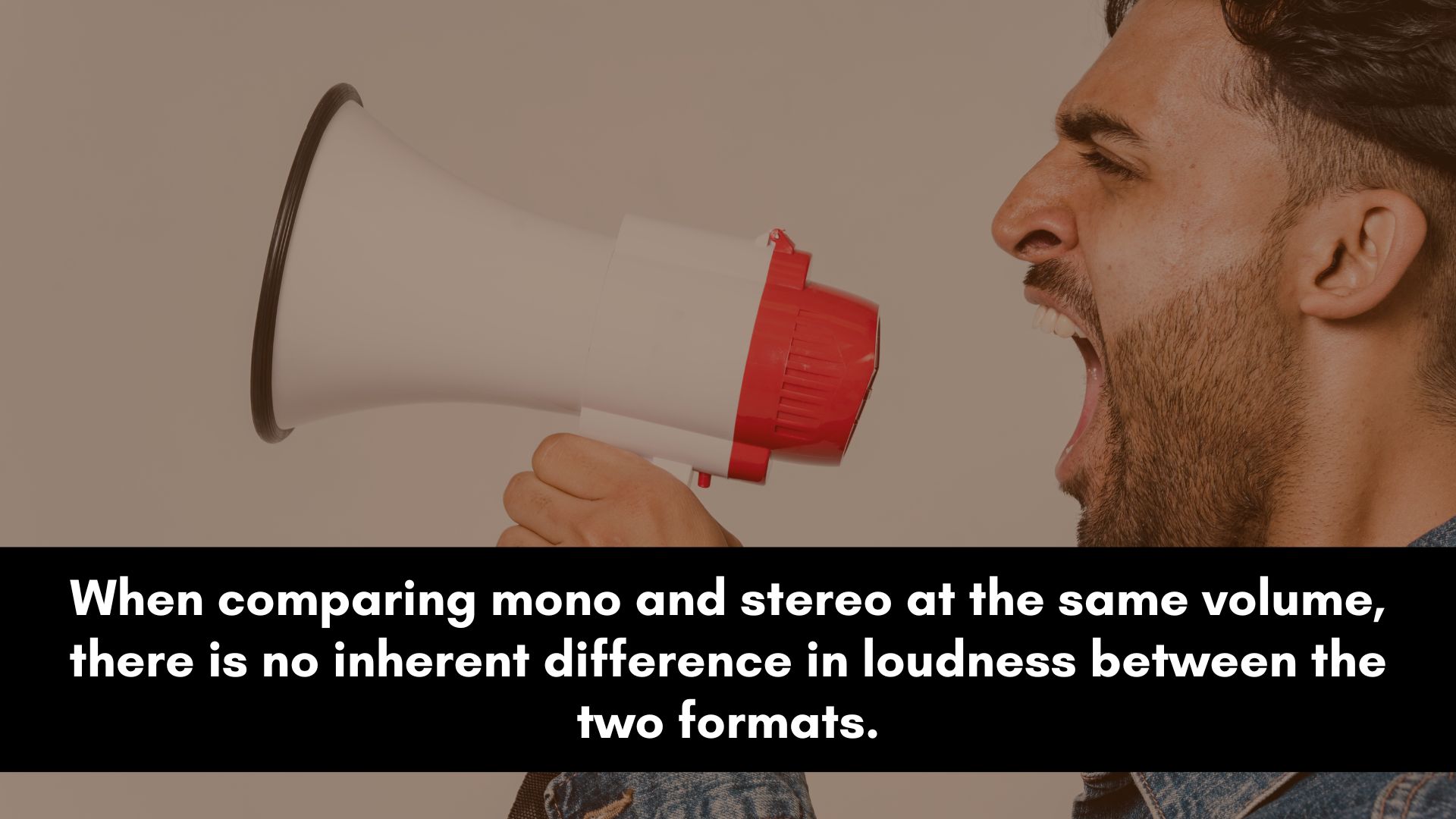When it comes to music, one of the biggest debates is whether to use mono or stereo.
Both types of sound have their advantages and disadvantages, and choosing the right one depends on your preferences and needs.
Mono vs Stereo Explained
In today’s post, we’ll explore the differences between mono and stereo and help you decide which one is better for your music.
Let’s start with the basics.
What is Mono?

Mono is an abbreviation for "monophonic" sound, which is recorded or played back in a single channel.
Basically, the word mono simply means “one.”
This means that all the audio information is mixed together and played through a single speaker.
Mono is commonly used in older recordings and audio systems, as it requires less equipment and is easier to manage than stereo.
Hence, most clubs still set up their sound system in mono.
Some do that because they want the experience to be the same for everyone, no matter where they’re located inside the club.
What is Stereo?

Stereo, on the other hand, is a type of sound that is recorded or played back in two separate channels.
This means the audio information is separated into two parts and played through two speakers.
So what you hear from the left speaker is not necessarily the same as the information that’s coming out of the right speaker.
Stereo creates a more immersive and realistic listening experience, as it simulates the way humans hear sound in the real world.
Stereo is commonly used in modern recordings and audio systems because it offers more width and clarity than mono.
It can be a bit complex to set up and manage compared to mono. This is why most venues don’t prefer to set their sound in stereo.
What is the Difference Between Stereo and Mono?

The main difference between the two is that stereo uses two separate audio channels, while mono uses a single audio channel.
In a stereo recording, the audio is split into two separate channels, which are then played back through two separate speakers.
This creates a wider listening experience, as sounds can be panned between the left and right channels to create a sense of width and directionality.
Stereo recordings are often used in music, games, movies, and other audiovisual content.
When it comes to mono recording, the audio signal is mixed into a single channel, which is then played back through a single speaker.
Mono recordings are simpler and easier to manage than stereo recordings.
They are normally used for voice recordings, vlogs, podcasts, and other types of content where stereo image separation is not necessary.
Pros and Cons of Mono
Pros:
- Mono is simple and easy to manage.
- It is compatible with older audio systems and recordings.
- Useful for certain types of music, such as solo performances or podcasts.
Cons:
- Mono can sound flat and one-dimensional compared to stereo.
- It doesn’t offer the same level of depth and immersion as stereo.
- Can be limiting in terms of creative expression and experimentation.
Pros and Cons of Stereo
Pros:
- Stereo creates a more immersive and realistic listening experience.
- It offers more depth and clarity than mono.
- Allows for creative expression and experimentation with panning and spatial effects.
Cons:
- It can be more complex and difficult to manage.
- Stereo may not be compatible with older audio systems and recordings.
- Can be overused, leading to a cluttered and overwhelming sound.
FAQ:
Which is Better for Music?
The answer to this question depends on a few factors, including the type of music you’re recording or playing back, your personal preferences, and your equipment.
Some situations might need the simplicity and directness of mono, while some cases require the 3D experience of stereo.
They both have their place in music, and it’s up to you to decide which one is better for your particular situation.
Here are some general guidelines to help you decide:
- Solo performances, vlogs, radio, podcasts, and other spoken-word content may sound better in mono, as it creates a more focused and direct sound.
- Music that features a lot of vocals or acoustic instruments can also sound better in stereo, as it allows for more separation and clarity between different parts.
- Songs that feature a lot of electronic or synthesized sounds might benefit from stereo, since it allows for more creative experimentation with panning and stereo effects.
- Tracks that are featured in games or movies will give the listener a better experience in stereo rather than mono.
- If you’re working with older recordings or audio systems, mono could be the only option.
So, the decision between mono and stereo comes down to your personal preferences and needs.
Should Songs Be Mono or Stereo?

Whether a song should be in mono or stereo depends on several factors, including the genre of music, the intended audience, and the production goals.
Generally, stereo is preferred for most types of music, as it offers a wide and dynamic listening experience.
Stereo allows for more separation between instruments and vocals, which can enhance the clarity and dimensionality of the mix.
It also allows for more creative experimentation with panning and effects, which can add excitement and texture to the music.
However, there are some situations where mono may be more appropriate.
For instance, if you're working with older recordings that were originally recorded in mono, it may be best to leave them in their original format to maintain their authenticity.
Similarly, if you're working with a simpler genre of music, such as folk or acoustic music, mono may be a good choice to maintain the focus on the core elements of the song.
Ultimately, the best approach is to consider the unique characteristics of the song and experiment with different options to find the best fit.
Resource: Mixing in Mono vs Stereo
Dual Mono vs Stereo Which is Better?
Ultimately, whether you choose to use dual mono or stereo will always depend on the specific needs and goals of the audio signal that’s being recorded or played back.
Dual mono refers to the use of two separate mono channels, each with its own audio source and playback equipment.
This approach is often used in professional audio applications, such as film and video production, or advanced audio engineering where a high level of precision and control is required.
Stereo is typically used in music and other audio content where the goal is to create a dynamic and engaging listening experience.
In general, stereo is preferred for most types of audio content, as it offers a wider range of creative possibilities.
However, there are some situations where dual mono may be the better choice.
For example, if you want to delay, equalize, or compress the left and right channels differently, this is much simpler to accomplish in dual mono.
So careful consideration of the unique characteristics of the content can help determine which approach is most appropriate.
Should I Use Stereo or Mono on Headphones?

Headphones are designed to provide a stereo listening experience, meaning that they deliver audio to both the left and right ears separately.
Therefore, using stereo audio on headphones is recommended to achieve the most enjoyable listening experience.
However, there may be some situations where mono audio is necessary or preferred.
For instance, if you have hearing loss in one ear, listening to stereo audio may be difficult or uncomfortable.
In such cases, you can switch to mono audio to ensure that you are hearing all of the audio content evenly.
Additionally, some audio content, such as podcasts or audiobooks, may be primarily dialogue-based and not require the use of stereo audio. Therefore, using mono playback may be a suitable option.
In general, it is recommended to listen in stereo on headphones for most types of content.
However, it is important to consider individual needs and preferences, as well as the specific characteristics of the audio being listened to, to determine the best approach.
What is Louder, Mono or Stereo?

When comparing mono and stereo at the same volume, there is no inherent difference in loudness between the two formats.
Both mono and stereo can be adjusted in volume to achieve the desired level.
However, it is worth noting that the perception of loudness can be influenced by other factors, such as the presence of stereo effects, EQ, and compression.
In some cases, stereo audio may sound louder than mono, even if they are technically played back at the same volume level.
This can be due to the presence of spatial effects and other elements that can make the audio seem more dynamic and full.
Overall, it is important to adjust the volume of audio content to the appropriate level for the specific listening situation, regardless of whether it is in mono or stereo format.
The perceived loudness of the audio can also be affected by external factors, such as the quality of the playback equipment and the listening environment.